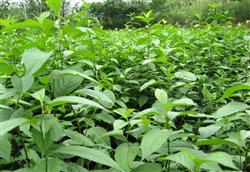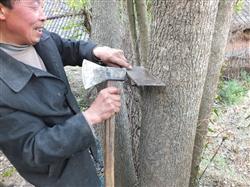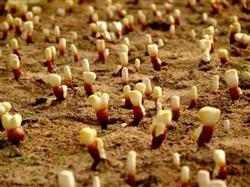How to raise seedlings of Eucommia ulmoides?

How to raise seedlings of Eucommia ulmoides? Please introduce the seedlings of Eucommia ulmoides including sowing and asexual propagation, the methods are as follows: seed seedling technology ① nursery preparation. Select a better slightly acidic soil nursery, apply sufficient base fertilizer in winter, after freezing, rake flat to make a bed in the following spring. Generally, 150kg cake fertilizer and 1500 kg barnyard manure are used every 667m. The seedbed can be made into 15 meters long, 1.2 meters wide and 30 centimeters high, leveling and raking fine to prevent stagnant water. ② seeds sprouted. If the seeds are sown in the middle and late March, they can sprout half of the time earlier. Generally, seeds and sand are mixed at the ratio of 1:10. The humidity of the sand is pinched by hand and dispersed. It is spread on the cool and ventilated floor indoors, with a thickness of about 30 cm, and keep the seed and sand moist. When the indoor temperature was kept above 6 ℃ during the budding period, the seeds could fully absorb water and expand, and when the white head appeared at the top gap of the Samara, that is, the radicle began to appear, the seeds could be sown in the finished nursery. Using low temperature and wet sand to accelerate germination of seeds, the germination rate can reach 80%, and the seedling rate is neat and consistent. If time is short and it is too late to use wet sand to promote germination, you can also soak seeds in 40 ℃ warm or cold water before sowing, but the germination rate is only about 50%. ③ ditch evenly spread 50-80 seeds, after sowing, cover 2 cm of large mud ash, relatively dry land, but also cover the soil with straw to moisturize. Generally, the seeding rate of 667 meters is 5-8 kg, and the seeds germinated by wet sand are unearthed 15-16 days after sowing. Seeds temporarily soaked in dry storage take 30 days to germinate and unearthed. ④ post-broadcast management. In the process of seed germination, the bed should always be kept wet, and if the weather is dry, water can be sprayed appropriately; after seed germination, cover grass should be removed in batches. In order to prevent the seedlings from being infected with bacterial blight, Bordeaux solution can be sprayed regularly once a week. When 2-4 true leaves appear in the seedlings, the first loosening and weeding can be carried out, and the dilute urea solution can be applied once, and the concentration is about 1%. The fast-growing period of seedlings is from June to August, and soil loosening should be strengthened at this time. Urea solution with a topdressing concentration of 2% can also be irrigated into human feces and urine. From September to October, in order to prevent the seedlings from freezing in winter, topdressing should be stopped and the roots of the seedlings should be covered with a layer of fiery soil ash to improve the cold resistance of the seedlings. The sprouting power of Eucommia ulmoides is very strong, and asexual reproduction is cutting method, pile regeneration method, root sprouting method, strip propagation method and residual root reproduction method. ① cutting method. The choice of nursery should be cool, moist, humic semi-sandy or incense lime soil is better. The cutting time is that before the new leaves germinate in early spring, the new annual branches are generally cut off and cut into 5 buds, the upper bud should be flat with the top section, and the lower cut surface is horseshoe-shaped. In this way, the cutting is inserted into the seedbed with the depth of 2 to 3 of the cuttings, the plant spacing is 8-10 cm, and the row spacing is 20-25 cm. Often keep the border soil moist after insertion, and set up a shed to shade in the high temperature season to keep cool and moist, which is beneficial to the growth of new roots and weeds in summer and autumn. Except for small, combined with topdressing, it can be transplanted in the next spring. ② retained column for regeneration. In May and June, when cutting down Eucommia ulmoides trees from the Beginning of Summer to the Summer Solstice, do not dig off the stump, because the cut stump can germinate and regenerate quickly. The stumps cut during this period can sprout in more than 30-40 days. In July, it takes 60 to 70 days for new seedlings to sprout, and some of them will sprout in October, but the young seedlings germinated in October are easy to freeze to death. Some of a tree stump can sprout several plants, and it is necessary to cultivate soil at the budding roots to facilitate the growth of new roots, so that they can be dug up and transplanted the following spring. ③ root sprouting method. Due to the strong germinating power of Eucommia ulmoides, the bark of the main root of Eucommia ulmoides can be cut and covered with soil, and new seedlings can germinate and grow (usually it is better to hurt the root before the sting). After a year, it can also be cut off and transplanted. ④ striping breeding method. Rain Water presses the branches of Eucommia ulmoides seedlings into the soil with soil or bricks or stones before and after early spring. As long as the soil is moist, the humidity is suitable, the depth is about 8 to 12 centimeters, and the branches are slightly exposed, so that the branches sprout new roots, they can be cut off and transplanted the next year. ⑤ root propagation method. In the seed nursery land, the seedlings were dug and planted in spring, and the lower part of the main root was consciously left in the soil, and then the original woodland was arranged, and after it germinated into seedlings, it was dug up as cultivated seedlings. Click to get more planting techniques of Eucommia ulmoides
- Prev

How to harvest and deal with Eucommia ulmoides?
How to harvest and deal with Eucommia ulmoides? Please introduce the method Eucommia ulmoides is a commonly used traditional Chinese medicine, harvest with peeling method. The more suitable time for peeling is from June 20 to July 31 in our province. During this period, the climate is suitable, Eucommia ulmoides is easy to regenerate new skin after peeling, and the survival rate is high. When peeling, the upper part of the trunk that will be peeled first.
- Next

Ganoderma lucidum cultivation technology: how to cultivate ganoderma lucidum?
How does Ganoderma lucidum grow? The artificial cultivation of Ganoderma lucidum in China began in 1960 and was successfully domesticated by Mr. Chen Meipeng, Institute of Edible Fungi, Shanghai City Academy of Agricultural Sciences. Ganoderma lucidum cultivation has two kinds: substitute cultivation and log cultivation. Substitute cultivation is to use artificial preparation of culture materials bagged, stacked in the shed culture...
Related
- Fuxing push coffee new agricultural production and marketing class: lack of small-scale processing plants
- Jujube rice field leisure farm deep ploughing Yilan for five years to create a space for organic food and play
- Nongyu Farm-A trial of organic papaya for brave women with advanced technology
- Four points for attention in the prevention and control of diseases and insect pests of edible fungi
- How to add nutrient solution to Edible Fungi
- Is there any good way to control edible fungus mites?
- Open Inoculation Technology of Edible Fungi
- Is there any clever way to use fertilizer for edible fungus in winter?
- What agents are used to kill the pathogens of edible fungi in the mushroom shed?
- Rapid drying of Edible Fungi

